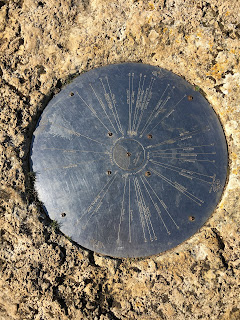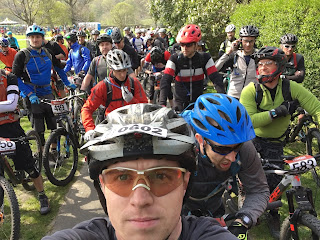Gloucestershire has an extremely rich and varied geology.
From the Carboniferous Limestone and Pennant Sandstone of the Forest of Dean that is underlain by huge thicknesses of Old Red Sandstone, through the ‘New Red’ sandstones and Lias clays of the flatter Severn Vale, to the Middle-Jurrasic Oolitic Limestone that forms the Cotswold hills, there is a lot going on.
For crying out loud, it’s recently taken delivery of some extra-terrestrial deposits all the way from the asteroid belt; just off Jupiter.
Winchcombe itself, the focus of this piece, sits very near to the edge of the Cotswold escarpment; nestled within an undulating, natural bowl formation with the escarpment to the south, Langley & Gretton Hills to the northwest and north, respectively, and Stanway Hill and Sudeley to the northeast and east, respectively.
This natural formation makes winchcombe a unique place. It has myriad hills and numerous rights of way or trails navigating many of them. These include The Winchcombe Way, The Gloucestershire Way and the Cotswold Way, which stretches all the way from Chipping Campden to Bath.
From churches to humble cottages, like most Cotswold settlements, Winchcombe has been imbued with a mellow, warm character from the golden yellow colour of the stone - to which many ‘honey-pot’ Cotswold towns owe their modern popularity and prosperity.
Once a significant settlement earning mention in the domesday book; its residents’ coffers filled by the wool trade, it was, at one point in history, regarded as the capitol of england (check reference). Winchcombe is now a simple, market town - although, it rarely hosts a market.
Whilst the prosperity that saw Winchcombe ascend to such lofty heights has gone, there remains many fine examples of high quality homes, some of considerable size or architectural quality, that demonstrates historic wealth. Almost all are built from the local stone; the characteristics of which make it a very good, and highly sought after, building material.
The gargoyles of St. Peter’s Church offer a really fine example of the affinity of Cotswold stone for not just Ashlar but banker work and stone carving, as well as more regular rubble and walling material. Out on the trails, this can be witnessed up close courtesy of the Guiting Hare and Frog statues (place pin marker and photograph).
The Cotswold Hills are composed from three different geological stages of the Jurassic period; dating from between 210-140 million years ago. The steep escarpment to the west of the Cotswolds exposes sections through Lower and Middle Jurassic rocks. It is these Middle Jurassic rocks that are the characteristic 'Cotswold Limestones'.
‘Cotswold stone’ is subdivided into the Inferior and Great Oolite Groups.
The Inferior Oolite, which caps the main north-west facing escarpment, is composed of up to 100m of oolitic limestones including the Cheltenham freestone - quarried most extensively at Leckhampton and used widely in the distinctive Regency architecture of Cheltenham.

In reality, riding trails in the Cotswolds, particularly if you venture away from the escarpment itself, you’ll most likely, with infrequent exception, experience conditions more attributable to the Great Oolite.
 The Great Oolite, sitting above the Inferior Oolite and forming the base to much of the rather barren Cotswold plateau, encompasses a variety of oolitic, shelly, sandy or marly limestone beds, many of which are used for building purposes such as dry-stone walling and roof tiles. Generally paler, off-white to grey, in places varying to brown, and course in texture.
The Great Oolite, sitting above the Inferior Oolite and forming the base to much of the rather barren Cotswold plateau, encompasses a variety of oolitic, shelly, sandy or marly limestone beds, many of which are used for building purposes such as dry-stone walling and roof tiles. Generally paler, off-white to grey, in places varying to brown, and course in texture.
Further afield (away from the escarpment, right up on the plateau, the golden hue of the stone has mixed with the overlying muds to create something even worse. Of a sticky, claggy, clay-like consistency and orange in colour, when wet, Cotswold Mud is the devil’s work.
Up on the plateau, there are small areas where traffic, weather, erosion has exposed more of the stone beds; particularly on steeper topography, which leads to the presence of pockets of loose, rocky trails. Away from the escarpment, however, these tend to be isolated sections where the trails are more focussed but, in most cases, the trails and bridleways pass through open fields and common land that undulates with less amplification.
And, you don’t need to venture far from the escarpment to find such conditions. Over the top of Cleeve Common, the exposed trails aren’t too bad but even here, where less obvious, they can become quite messy in winter. However, even where compacted, the binding is more sandy than claggy, and rideable, but venture over to the far side, at the end of the Gallops, and the trails change from the blonde, sandy colour to a much deeper shade of orange. In the summer, these trails ride fine, eventually joining back to the more rocky, exposed trail behind Belas Knapp but in winter they will stop you in your tracks, quite literally.
 I quite like a ride to be rounded in terms of trail type, technicality and flow and some of the best routes in the Cotswolds tick all three with blinding sections of singletrack mixed with some wooded loam, some high tech drop ins and flat out rocky descents. I think I tend towards the technical jeopardy of rockier trails compared to mud/rooty trails and, as such, the majority of my favourite trail sections within the Cotswolds are located somewhere along the escarpment and orientated downwards.
I quite like a ride to be rounded in terms of trail type, technicality and flow and some of the best routes in the Cotswolds tick all three with blinding sections of singletrack mixed with some wooded loam, some high tech drop ins and flat out rocky descents. I think I tend towards the technical jeopardy of rockier trails compared to mud/rooty trails and, as such, the majority of my favourite trail sections within the Cotswolds are located somewhere along the escarpment and orientated downwards.
From Broadway and Stanton all the way to Cleeve and Leckhampton there are a fair share of rocky descents to pick from but, some of my favourite routes actually venture much further in to the depths of the plateau where peace and quiet can be appreciated amongst beautiful views and serene singletrack. They are, however, also far more prone to weather and conditions so not as rideable as often.
Snowshill is a good example. Starting/finishing at the bottom of the escarpment, there is myriad choice of great, rocky descent back in to Laverton, Stanton, Stanway & Hailes, to name a few, but the top is just not worth it unless preceded by a few weeks of dry (and warm) weather or off the back of a heavy frost, lest you want to carry the bike for the most of it (yes, that has happened - i thought it’d get better. It didn’t).
The great thing about the Cotswolds is that no ride is ever the same, there’s too much to choose from to be so restrictive and, no matter what the weather and trail conditions are, they’ll always be a route that works. Getting the maps out and piecing those routes together is half the fun of it (for me, at least) and knowing which routes will work and which are best avoided is simply down to experience and knowledge (I have been caught out enough times from ill begotten ventures down unsuitable trails, only to find myself scraping the clay from the tyres cos they simply won’t turn anymore before eventually giving up and dragging the bike to more suitable conditions, to know where is crap and when).













































